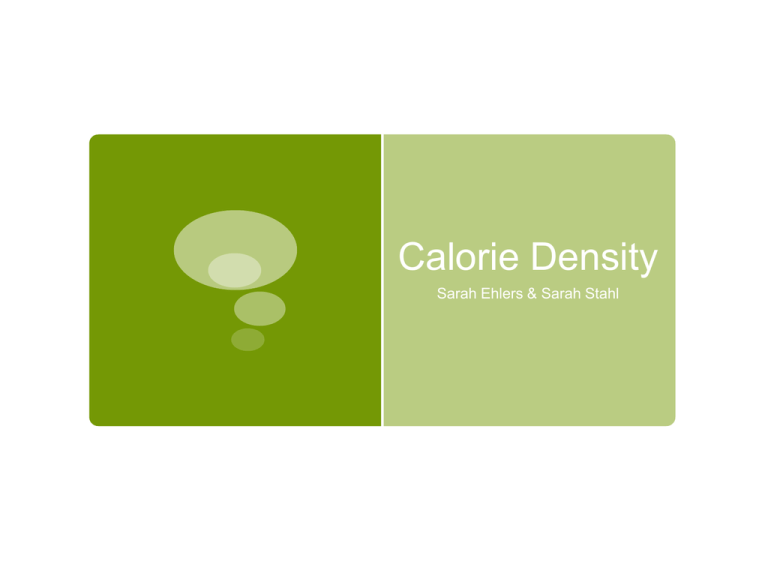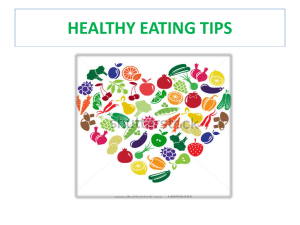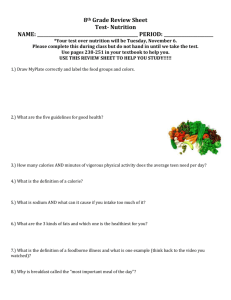File
advertisement

Calorie Density Sarah Ehlers & Sarah Stahl Objectives To understand what nutrients make up a calorie and how much they absorb Demonstrate the science behind intake and production of energy Reason behind overconsumption of calories To be able to make high density, low calorie choices when making food and meal choices Gain knowledge about the pros and cons of the Volumetrics Diet What is Calorie Density Also called energy density The measure of calories per weight unit Number of calories per serving/ number of grams(or oz, lbs, etc.) per serving Is a pound of bricks the same as a pound of feathers What is a calorie?(1) Unit of measurement Actually a kilocalorie when talking about food. Provides energy for body function Is not a nutrient, but provides nutrients. Physiological Fuel Value of Food(1) Reflected by Bioavailability of energy in food is slightly less Inability to derive energy from nitrogen in protein What Makes Up a Calorie? (1) Nutrients 9 kcals/g for fat (9.45 kcal/g *0.95) 4 kcal/g for carb (4.15 kcal/g * 0.98) 4 kcal/g for protein [(5.56 kcal/g-1.3 kcal/g)* 0.92] Multiply due to amount of actual absorption Nutritional calorie (1) 1 “nutritional calorie” = 1 kilocalorie (kcal), which is 1000 small calories 1000 calories= 1 kilocalorie Capital “C” in Calorie derives from “large calorie” Even when lower case, still refers to kcals. Calorie Equivalents (1) 1 kcal is the amount needed to raise temperature of 1kg of water, 1 degree Celsius “heat is energy” 1oz (28.4g) piece of sweet chocolate provides about 143 kcal (143,000 calories) So, 1oz sweet chocolate is necessary to bring about 1.5 qt (6cups) of “ice cold” water to a boil. Kilojoules (1) Food energy can also be measured in kilojoules Kilojoule: unit of how much work required to use up calories. 1 kJ = 1,000 Joules 1 kcal = 4.184 kJ or about 4.2 kJ 1oz chocolate What does this say to you? How we get from calorie to energy (2) Broken down in the body by metabolic process STEP 1- Enzymes act upon the different nutrients Carbs glucose & other sugars Proteinamino acids Fats glycerol and fatty acids Metabolic process cont. (3) Step 2- These molecules are then transported through the blood stream to get to the cells Absorbed and used for immediate use of energy Or sent to be stored for “a rainy day” Excess Calorie Consumption If more calories are consumed than are used, body stores excess as fat. 3,500 extra cals consumed = 1 lb of fat gain *keep in mind that metabolic rates, hormones, and other factors play a role in metabolism Mindless Eating (4) Brian Wansink- Cornell University Make over 200 food choices per day on average Bottomless Super BOWLS Study 1 gallon bowl vs 2 half gallons 1 gallon bowl consumed 53% more calories on average Educated students Brian Wansink (5) “Some people, particularly obese people, can underestimate how much they eat by almost 50 percent” “We make about 200 decisions concerning food each day and we're not, conscious of about 180 of them.” “If a movie theater gives us a free bucket of popcorn, we'll eat it, even if it's 14 days old and so stale that it tastes like packing material” How Does Energy Density Prevent Overconsumption of Calories? High dense foods are lower in calories and higher in nutrients Eat more food Less is not always more! Feel full less likely to overeat or feel hungry 20 minutes after a meal Satisfy hunger Less calories less fat storage A diet should not equal hunger! High Density, Low Calorie Food-Water (6) Water takes up space too! Helps establish huger vs. thirst High water content provides volume & weight and few calories 100g carrots at (88% water) provides 43 kcal [4] 100g cashews (2% water) yield 574 kcal [4] Total Fiber-Definition (7) Struggle with consistent definition Dietary Fiber: non-digestible carbohydrates & lignin that are essential & intact in plants Naturally occuring Functional Fiber: “Isolated, nondigestible carbohydrates that have beneficial physiological effects in humans” TOTAL FIBER- sum of dietary & function fiber Fiber-Go Straight to the Source (8) “More you remove, more fiber you lose” Removal of fiber usually results in addition of sugar Medium apple w/ peel Medium apple w/o peel 2.1 grams One cup apple sauce 4.4 grams 2.7 grams One cup apple juice 0.5 grams Soluble Vs. Insoluble Fiber (7,8) Soluble - “sponge” – slows digestion Flax seeds, nuts, oats & bran Lower cholesterol Blood sugar regulation Preventing heart disease and diabetes control Insoluble- speeds digestion Skin, broccoli, stems, whole wheat Apple juice? Apple sauce? Or whole apple? Food examples Fruits, vegetables, soup, whole grains, lean protein…. Foods that are low densityhigh calorie Fatty foods Fried foods Added sugar Processed foods White grains Breakfast-the most important meal of the day What would you choose? Snacks100 cals http://www.youtube.com/ watch?v=a1UZGGbjgM8 Keep in mind…. (9) Not all energy dense foods are bad for you, but portion size should always be considered High density, low calorie foods also provide HDL’s, not all LDL’s Nuts & seeds Peanut butter Hara hachi bu – or “eat until you are 80% full” Okinawan Island, Japan Volumetrics Diet/ “Volumetrics Eating Plan” (10) Created by nutritionist Barbara Rolls, Phd “The volumetrics diet doesn’t require dieters to eat less, just eat nutritious, less dense foods that will fill you up.” -via the volumetricsdiet.com Claims self control, not portion control Both important for healthy lifestyle Positive Science Based Evidence (10) 5 Common Diet Dilemmas listed on Volumetricsdiet.com Answered by RD, Dr. Jenna A. Bell Wilson 1. Do Low-calorie sweeteners make me fat or eat more? 2. Eating in the evening make me gain more weight? 3. Will specific foods help me burn fat 4. Low/no fat = no calories. Right? 5. Will a crash diet or fast jump start my weight loss? Negative aspects of the Diet (10) Tends to be higher priced Fad diet encourages consumption of a higher volume of food in one sitting Energy dense or not, overeating is over eating Biased approach to convince consumers Scientific facts are presented, but nonfactual opinions take facts out of contex Why is it important?(11-15) High density low calorie foods have high nutrient and antioxidant density Vitamins & nutrients required for daily performance & body function Cancer prevention Gain/lose weight Obesity, type II diabetes, metabolic syndrome High fiber Decreased heart disease risk Works for all age groups Ways to Eat High Dense, Low Calorie Foods On a Budget (16,17) Buy canned and frozen vegetables Canned soups can be high in water content and also cheap be aware of sodium content! Whole grain pasta can be very cheap and is also filling Apples are usually low cost year round Read nutrition label, want foods with high fiber or high water content As a Dietitian…. (18) Where are kids getting their empty calories from? 2009-2010 NHANES DATA 33% from stores Stores provided majority of kcal intake (436kcals) 32% from schools 35% from fast food restaurants As a Dietitian…(18) Sources were similar Stores: sugar-sweetened beverages, grain desserts, high-fat milk School: high-fat milk, grain desserts, pizza Fast-Food Restaurants: sugar-sweetened beverages, dairy desserts, french fries, pizza Resources Myplate eatright.org Dietary Guidelines NHANES & CDC Data References 1. Rye JA. Exploring Dietary Kilocalories: An Activity Exemplifying the Personal Value of Science and Mathematics. SSMILes 1999; 99(2): 94-101. 2. Stubbs RJ, Whybrow S. Energy density, diet composition and palatability: influences on overall food energy intake in humans. Physiology and Behavior 2004; 81: 755-764. 3. Rolls BJ. Relationship between dietary energy density and energy intake. Physiology and Behavior 2009; 97: 609-615. 4. Brian Wansink [streaming video]. YouTube. Super Bowls and the Super Fat. 2011. Available http://www.youtube.com/watch?v=heFiA1lAhe4. 5. HALICKS R. Q&A / BRIAN WANSINK, nutritional scientist: People caught up in mindless eating. The Atlanta Journal - Constitution 2006 Oct 29:0. 6. Monsivais P, Drewnowski A. Lower-energy-density diets are associated with higher monetary costs per kilokalorie and are consumed by women of higher socioeconomic status. J Am Diet Assoc. 2009;109:814822 7. Slavin JL. Dietary fiber and body weight. Nutrition 2005; 21(3): 411-418 8. .Apples or Apple Juice?. http://www.eatright.org/kids/tip.aspx?id=6442473542&terms=fiber 9. Another mince pie? Scientists find the secret to a long, indulgent life. The Independent 2011 Dec 20:19. 10 . Volumetrics Diet, eat more lose more. http://www.volumetricsdiet.com 11. Devitt AA, Mattes RD. Effects of food unit size and energy density on intake in humans. Appetite 2004; 42:213-220. 12. Hunt JN, Cash R. Energy density of food, gastric emptying and Obesity. Department ofPhysiology, Guy’s Hospital Medical School. 13. Scourboutakos MJ, L’Abbé MR. Restaurant Menus Calories, Caloric Density and Serving Size. Am J Prev Med 2012; 43(3):249-255 14. Rolls B. Energy Density and Nutrition in Weight Control Management. In The Permanente Journal, 2003;7(2). 15. Gedney M. What is Calorie Dense vs. Nutrient Dense Food? 2013. http://healthyeating.sfgate.com/caloriedense-vs-nutrientdense-food-5391.html 16. Drewnowski A. Obesity and the Food Environment dietary energy density and diet costs. Am J Prev Med 2004;27(3S): 154-162. 17. Darmon N, Darmon M, Maillot Matthieu. A nutrient density standard for vegetables and fruits: Nutrients per calorie and nutrients per cost. J Am Diet Accoc 2005. 18. Poti JM, Slining MM, Popkin BM. Where Are Kids Getting Their Empty Calories? Stores, Schools, and Fast-Food Restaurants Each Played an Important Role in Empty Calorie Intake among US Children During 2009-2010. JAND 2013.





